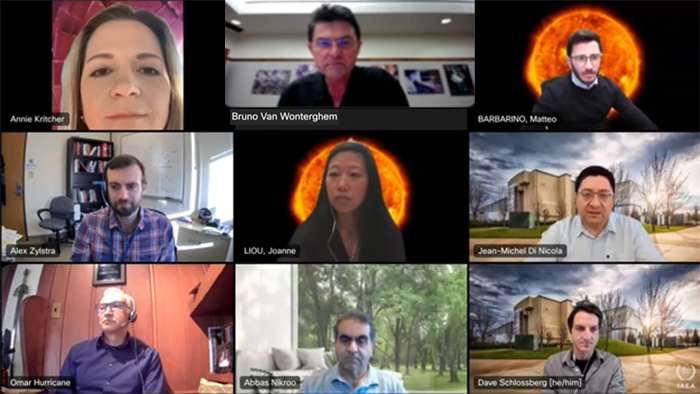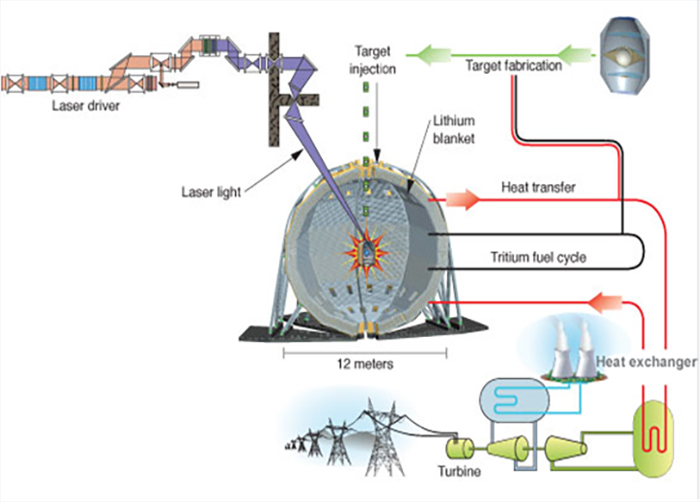IAEA Webinar Explores LLNL’s Ignition and Energy Gain Breakthroughs
March 6, 2023
The Dec. 5, 2022, LLNL experiment that achieved scientific break-even and fusion energy gain for the first time in a laboratory showed that there are no “mystery physics obstacles” standing in the way of producing as much or more energy from a fusion reaction than the energy needed to drive the reaction.
The research leading to that “existence proof” of ignition and energy gain was described by Omar Hurricane, chief scientist for LLNL’s inertial confinement fusion (ICF) program, in a Jan. 19 webinar sponsored by the International Atomic Energy Agency (IAEA).
After decades of laser research and development at LLNL and 12 years of ICF and related experiments on NIF, “we can now talk about burning plasmas, ignition, and scientific break-even in the past tense,” Hurricane said. “That’s super exciting.”
 Participating in the IAEA Webinar on NIF’s fusion breakthroughs were (from left) top row: Annie Kritcher, Bruno Van Wonterghem, and Matteo Barbarino, IAEA nuclear fusion specialist; middle row: Alex Zylstra, Joanne Liou, IAEA public affairs specialist, and Jean-Michel Di Nicola; bottom row: Omar Hurricane, Abbas Nikroo, and Dave Schlossberg. (Video is below)
Participating in the IAEA Webinar on NIF’s fusion breakthroughs were (from left) top row: Annie Kritcher, Bruno Van Wonterghem, and Matteo Barbarino, IAEA nuclear fusion specialist; middle row: Alex Zylstra, Joanne Liou, IAEA public affairs specialist, and Jean-Michel Di Nicola; bottom row: Omar Hurricane, Abbas Nikroo, and Dave Schlossberg. (Video is below) Hurricane, who was joined by six other LLNL scientists for the webinar, noted that the Dec. 5 experiment had to overcome a number of “target physics challenges that frustrated our progress,” including instability control, symmetry control, energy coupling, target quality, and compression.
“The implosion physics was more sensitive to engineering control of the laser and targets than originally thought,” Hurricane said.
Success came after years of addressing the problems and building understanding in steps, making use of diagnostic data and computer modeling and simulation to make incremental, evolutionary changes that improved the experimental designs, “and trying to finesse things in a regime where Mother Nature is working against you,” he said.
“NIF was not designed to be energy efficient; it was designed to demonstrate scientific break-even.”
—Jean-Michel Di Nicola
Annie Kritcher, the December experiment’s lead designer, said the ignition design was a culmination of many years of “developing models and cross-checking those models against experimental data—analytical models as well as complex radiation hydrodynamics simulations. We’ve been calibrating our understanding to our experimental data and then using those calibrated models to make design improvements.”
“No one thing” can guarantee success, Hurricane added. “All of these elements have to come together at the same time to get ignition with an ICF target.”
A Laser Energy Boost
Another important factor in achieving ignition, he said, was the “years of effort by the laser engineering team” to increase the ultraviolet energy delivered to the fusion target by NIF’s lasers—from the facility’s design specification of 1.8 million joules (MJ), to recent shots achieving about 1.9 MJ, to 2.05 MJ in December.
The higher energy, coupled with an 8 percent thicker target capsule and improved implosion symmetry, enabled NIF to produce 3.15 MJ of fusion energy—more than double its previous record energy yield.
Jean-Michel Di Nicola, NIF laser systems chief engineer, said the energy boost was made possible by minimizing energy losses in the laser; mitigating the migration of debris from the target area to the optical components; developing new coatings and material fabrication processes to enable NIF’s optics to withstand higher-energy shots without incurring damage; and shaping the laser beams through time, frequency, and space.
“We are flattening the beam as much as possible,” he said. “For a given laser aperture you can optimize the delivered energy without (creating) hot spots that could increase the risk of damage initiation in the optics.”
Di Nicola said the team plans to increase NIF’s energy by an additional 8 percent over the summer, “which will provide more margin for ignition shots.”
Prospects for Fusion Energy
NIF’s primary mission is to support the National Nuclear Security Administration’s science-based Stockpile Stewardship Program to maintain the reliability and security of the nation’s nuclear deterrent without underground testing. But the December result has also intensified recent interest in fusion’s potential as a clean, safe, reliable, and sustainable energy source.

Responding to a question about the prospects for commercially viable inertial fusion energy (IFE), NIF Deputy for Targets and Physics Abbas Nikroo said an IFE power plant would need to fire its lasers at about 10 Hertz (10 times a second) to produce a continuous flow of energy for electricity production.
NIF, a research facility and not a fusion reactor, typically is able to fire a few times a day. “We would need to shoot at about a million times a day,” Nikroo said. “There would have to be major engineering advances to be able to make targets at that rate, and shoot the laser that many times, and deal with all the (radiation) in the (target) chamber.
“And then on the physics side,” he said, “I think we would need an energy gain of about 100 or so. So, we have a way to go.”
“And also make the laser more efficient,” added Di Nicola. “NIF drew about 300 to 400 megajoules out of the electrical grid” for the ignition shot, he said. “NIF was not designed to be energy efficient; it was designed to demonstrate scientific break-even.
“But we now know how to make lasers way more efficient, at the tune of 10 to 20 percent wall-plug efficiency, so we would use this type of laser firing at 10 Hertz or so to make it viable.”
Another path to significantly higher energy yields, according to Hurricane, would be to find ways to make high-compression, high-gain implosion designs work as expected. NIF’s high-yield experiments to date, including the ignition shot, have used low-gain designs, he said.
“We’ve always had a problem of our computer models predicting more compression than we actually observe in reality, and that has been frustrating,” he said. “In cases where we do get high compression, the target fusion performance has been lackluster for reasons we do not yet understand.
“If you are limited in your ability to compress you will always be limited in terms of the burn efficiency, so this is a problem that we need to address (the Dec. 5 shot burned about 4.6 percent of the fusion fuel while the shot from August 8, 2021, burned about 1.9 percent).
“This is actually just one of many things we want to explore going forward,” Hurricane said. “So, I’d say this is the end of the beginning. There’s more work to do.”
Also participating in the webinar were Alex Zylstra, chief experimentalist for the ignition experiment; NIF Facility Manager Bruno Van Wonterghem; and Dave Schlossberg, science lead for the NIF Nuclear Diagnostics group.
More Information:
“Star Power: Blazing the Path to Fusion Ignition,” NIF & Photon Science News, February 23, 2023
“Designing for Ignition: Precise Changes Yield Historic Results,” NIF & Photon Science News, March 1, 2023
“Tokamaks, Stellarators, Laser-based and Alternative Concepts: Report Offers Global Perspective on Nuclear Fusion Devices,” IAEA News Release, February 20, 2023
“Milestone Shot Enhances Future of Stockpile Stewardship and Fusion Energy Science” NIF & Photon Science News, Feb. 15, 2022
“Self-heating plasmas offer hope for energy from fusion,” Nature, Jan. 26, 2022
“Threshold of Ignition: A NIF & Photon Science News Special Report”
—Charlie Osolin
Follow us on Twitter: @lasers_llnl



